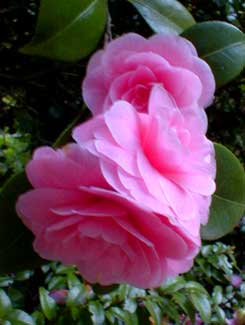
'Ice Follies' Camellia
"At the break of dawn
the well-bucket reels in
a camellia bloom."
-Jamamoto Kakei,
(1648-1716)
(1648-1716)
This pink camellia grows in an alley cul de sac across the street from us, a little tree-sized shrub of twelve or fifteen feet height & ten feet width. It blooms mid-March to mid-April, brightly pink semi-double blossom.
There are large trees to the sunset-side of the cul de sac, so the camellia is in a shady location well protected from the western sun. It shares this spot with a humongous Pieris japonica & a very large Aucuba, all shade-loving broadleaf evergreen shrubs that have reached truly substantial sizes.
There are so many hundreds if not thousands of cultivars that I may never be certain of its identification, but I've decided it is almost certainly 'Ice Follies,' despite that it is so much larger than the average size of 'Ice Follies.'
'Ice Follies' was so-named because very cold-hardy, to minus 10 degrees Fahrenheit, suitable for zones 6 through 8. It was bred in the Potomac Valley by Dr. William L. Ackerman, who continued his breeding experiments in his own back yard after retiring from the National Arboretum. Dr. Ackerman is recognized as the leading authority on cold-hardy camellias, having written the book Growing Camellias in Cold Climates (2002).
He developed several cold-hardy camellias of varied appearance & habit & hybrid heritage, several of which having become garden standards under the series name "Ice Angels," including the very commonly offered 'Ice Follies.'
In appearance 'Ice Follies' looks like & blooms simultaneously with C. japonica. These spring-flowering camellias will never be my favorites, despite that we did plant one inside our own garden, the cultivar 'Brilliant.' I am vastly more fond of C. sasanqua types which include wall-climbers, & which bring lavish color to autumn & winter gardens.
Spring-flowering camellias are imperfect by my measure because they go through a very long period of homeliness as the blooms are turning brown & sometimes turning mushy, but refusing to drop from the branches for weeks on end. They don't exactly make up for this tendency by falling apart very well whenever someone is foolish enough to attempt them in bouquets. They are additionally apt to become rather bad looking if they end up in too much sun.
But they are very popular around Puget Sound as we have the ideal weather for camellias of all sorts, & are widely regarded as the ideal shrubs for bringing large lavish flowers to shady spots.